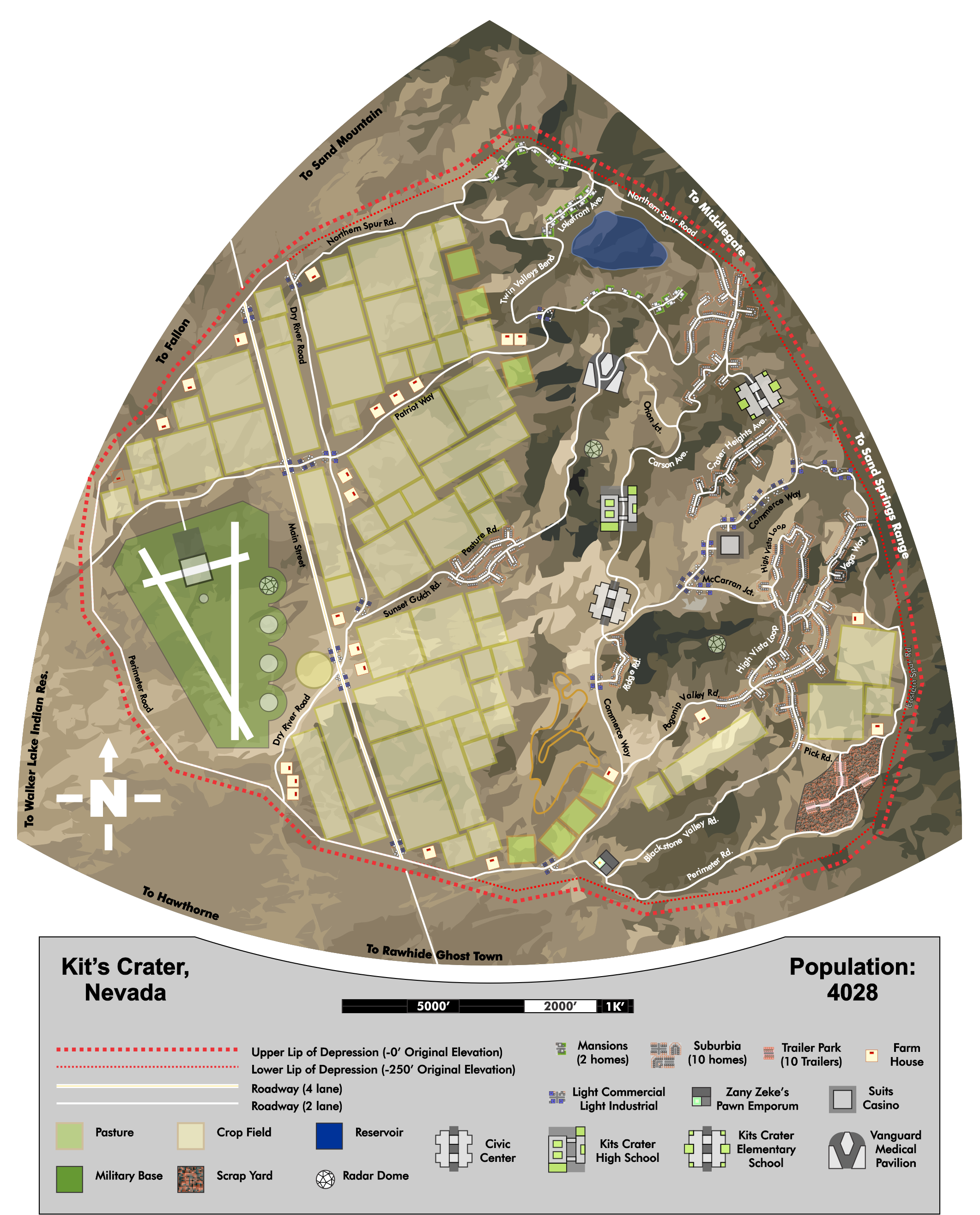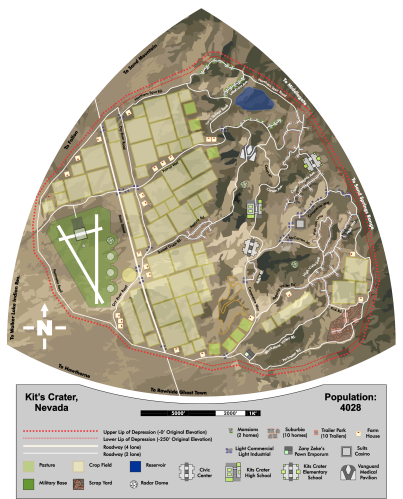Kit's Crater, Nevada
Kit's Crater is an incorporated community in central Nevada, USA. The town is located east of Fallon, east-northeast of Walker Lake, south of Sand Mountain, and northeast of the ghost town of Rawhide.
Named after famed explorer Kit Carson, The town was founded in the 1940's as a bedroom community for the local military base, situated alongside the base within the eponymous crater. The environs of Kit's Crater have a storied history of mining, seismic upheavals, secret military projects, and the vices of gambling and prostitution; nevertheless, the town itself is a sleepy conservative community rarely visited by outsiders.
Demographics
In terms of ethnicity, Kit's Crater's population is 80% White, 8% Hispanic, 7% Native American, and 5% other ethnicities. The vast majority (%91) of residents are Christian, with Mormon, Protestant, and Catholic being the predominant denominations. An unknown quantity of locals are involved with the Golden Cloister, and none of these individuals are willing to truthfully answer about this faith to any census. The population skews young due to the relatively short history of the town and the majority of the population having family connections to the military personnel stationed at the nearby air force base. Kit's Crater enjoys a sizable middle class, with the vast majority of adult residents possessing some form of secondary education or trade certificaiton. Military service, agriculture, mining, construction, and casino gaming are the the most common areas of work.
Government
Kit's Crater is headed by a mayor and city council who hold regular town hall meetings to air the political issues of the day. The local bureaucracy is small and efficient. While relatively conservative by 1986 standards, Kit's Crater politics also have a notable libertarian streak. Like much of the state, gambling, prostitution, and the open carry of firearms are all firmly legal within city limits, and any non-private areas of the desert are open for exploration, motor sports, and hunting. Kit's Crater has a small municipal court and two permanently stationed sheriff's deputies; serious criminals get sent out of town for prosecution and incarceration. Felonies are relatively rare in Kit's Crater, with most crimes committed within city limits involving driving infractions, alcohol, or domestic disputes.
Defences
Kit's Crater's relative isolation within the arid Nevada desert - blazing hot in the summer and icy cold in the winter - provides ample environmental protection from outside threats. Furthermore, the cliff walls of Kit's Crater average 250ft deep, effectively rendering the town unapproachable and invisible to outsiders. Sloping tunnels connect the town's road network to I-80 near Sand Mountain, though the entrance is purposefully placed behind a hill and only accessible via an unmarked, unpaved road; most people driving by the access road never notice it.
The original purpose of the town was to provide infrastructure and housing for the local United States Air Force research base, and this would be the primary staging area for defense against both military threats and the (much more common) natural disasters such as the occasional brush fire. Three large experimental sensor domes on high points around town allow the research base to triangulate the locations of objects in the surrounding airspace with unparalleled accuracy.
A Churchill County Sheriff office within the Kit's Crater Civic Center houses two (previously three) deputies who can deal with criminal threats. The deputies can call upon MPs from the Air Force base if a situation involves military personel or, if the situation involves gambling, a state Gaming Commission officer is also available to assist. Kit's Crater possesses a volunteer fire brigade. The Vanguard Medical Pavilion provides provides the town with two ambulances and two rescue helicopters.
Industry & Trade
Kit's Crater is largely self-sufficient, with cattle, garlic, onions, and alfalfa serving as the town's primary agricultural products. While the local mining prospects largely dried up before 1920, small amounts of silver and gypsum are still pried from the dry earth for use in industry. The Air Force base and the Vanguard Medical Pavilion, which is also an extension of the University of Nevada as a teaching hospital, routinely "share the load" with regards to lab chemistry and computing power (at least where non-classified information is concerned). Kit's Crater boasts a small hospitality industry, with the Suits Casino serving airmen on shore leave or the rare outsider who stumbles across the town.
Infrastructure
The paved streets of Kit's Crater (as shown on the map) were constructed with federal grant money, though most agricultural land is accessible via lightly-maintained dirt or grave roadways. No waterway in town, whether permanent or temporary, is large enough to warrant a bridge. While Kit's Crater does possess a number of water towers for municipal supply, most residents use septic systems and wells to supply water for day-to-day use. Electricity is supplied by power plants elsewhere in the state, though these lines cross the desert in secluded areas to help conceal the town's location. A small geothermal power plant is slated to begin construction in the Spring of 1988 along the south-southeastern reach of Perimeter Road (next to the scrapyard), which will grant the town energy independence from the rest of the state. Much of the light industry in the town is either involved in the processing of agricultural products or in supplying the farms themselves with equipment.
Architecture
Civilian buildings in Kit's Crater hearken back to previous eras in terms of architecture, especially post-WWII Americana and a few reconstructed brick buildings dating back to the state's silver mining era. Colorful neon and marquee signs abound due to the local gambling tradition.
Geography
Kit's Crater is situated within the eponymous crater, created when a previously undiscovered aquifer in the area partially collapsed as a result of seismic tremors from nearby nuclear testing. The walls of the resultant crater average 250' deep, though (unlike a meteoric crater) the edges are not raised above the original ground level. This geological upheaval rearranged the contours of the mountains which dominate the eastern half of town, turning the dark mountain to the southeast into a series of low, irregular hills. The western half of town is a broad, relatively flat gulch, with a slight slope to the west and numerous dry creek beds crisscrossing the landscape. Civil engineering efforts early in the town's history created a reservoir in the northeastern hills, creating a trendy local camping spot and expensive "waterfront" property. As a result of the terrain, Kit's Crater is largely invisible to observers beyond the walls of the crater, though light pollution filtering up through the crater's inversion layer can sometimes be seen at night. From Main Street, the town appears sparsely populated, as the western mountain ranges conceal the bulk of the town from the eyes of visitors.
The terrain of Kit's Crater is mostly hard-packed soil, chalk sediment, and granite. Before the "Collapse", as the cave-in of the aquifer is known by the locals, the geology of the area was largely defined by two major factors: the fact that the region was once a seafloor (as much of the Great Basin was) and the fact that human mining efforts had created large voids within the earth in areas which subsequent builders would have to deal with. Luckily, unlike Virginia City, many of the mineshafts partially or completely caved in as a result of the Collapse, reducing the potential for sinkholes in the town proper. Even with the Collapse, numerous underground waterways and hot springs supply the town with ample drinking water, setting the town apart from surrounding desert communities.
Founding Date
1947
Alternative Name(s)
New Rawhide
Type
Town
Population
4028 known permanent residents
Inhabitant Demonym
Craterites
Owner/Ruler



Comments